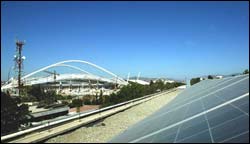This topic covers issues related to energy generation, conversion, transportation and consumption and how the industry is addressing the challenge of energy efficiency in general.
innovations-report provides in-depth and informative reports and articles on subjects ranging from wind energy, fuel cell technology, solar energy, geothermal energy, petroleum, gas, nuclear engineering, alternative energy and energy efficiency to fusion, hydrogen and superconductor technologies.

Solar hydrogen fuel dream will soon be a reality
Australian scientists predict that a revolutionary new way to harness the power of the sun to extract clean and almost unlimited energy supplies from water will be a reality within seven years.
Using special titanium oxide ceramics that harvest sunlight and split water to produce hydrogen fuel, the researchers say it will then be a simple engineering exercise to make an energy-harvesting device with no moving parts and emitting n

Scientists from the U.S. Department of Energy’s Brookhaven National Laboratory and the University of Florida have uncovered information that may help “molecular wires” replace silicon in micro-electronic circuits and/or components in solar energy storage systems. The scientists were studying how electric charge is distributed in polymer molecule chains that are several nanometers, or billionths of a meter, in length.
Brookhaven chemist John Miller, the study’s lead scientist

In time for the Olympic Games RWE SCHOTT Solar has begun operation of the country’s largest rooftop solar-energy unit in Athens. Supported by its Greek and German partners, this will help the company to further strengthen its market position in Greece.
“With this unit on the roof of the German School in Athens we aim to encourage the Greek government in introducing an incentive scheme along the lines of the German Feed In Tariff”, comments Dr. Winfried Hoffmann, Spokesman for the B

An electricity meter that sometimes runs backwards is just one of the cool aspects of Department of Energy near-zero-energy homes.
While low or no electric bills are an obvious benefit, high energy efficiency homes and businesses also reduce the amount of electricity that needs to be generated, thus reducing pollution, said Jeff Christian of DOE’s Oak Ridge National Laboratory.
In Tennessee, air pollution is of special concern as the state ranked third behind Cal

As the dog days of summer approach, the electrical grid feels the heat, but a new integrated data network may help the aging transmission system weather the season without another massive blackout like the one experienced over much of the Eastern United States and Canada last August.
The Eastern Interconnection Phasor Project will “go live” this summer providing the first real-time, system-wide data to utilities and transmission operators within the Eastern power grid.
“I

H2i Technologies of France is to present its new, innovative user-machine interface at the Electronica show to be held in Munich in the autumn. This cutting-edge, patented optoelectronic technology re-invents data-entry systems for industrial and medical equipment as well as consumer and household goods by making it possible for any surface to be fully interactive – thus leading designers and engineers to re-think the ergonomic and other features of the devices they make.
As the winner of